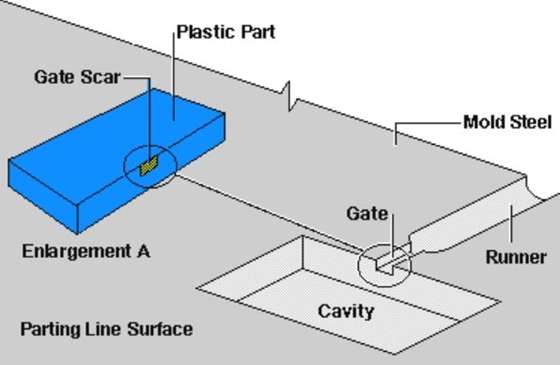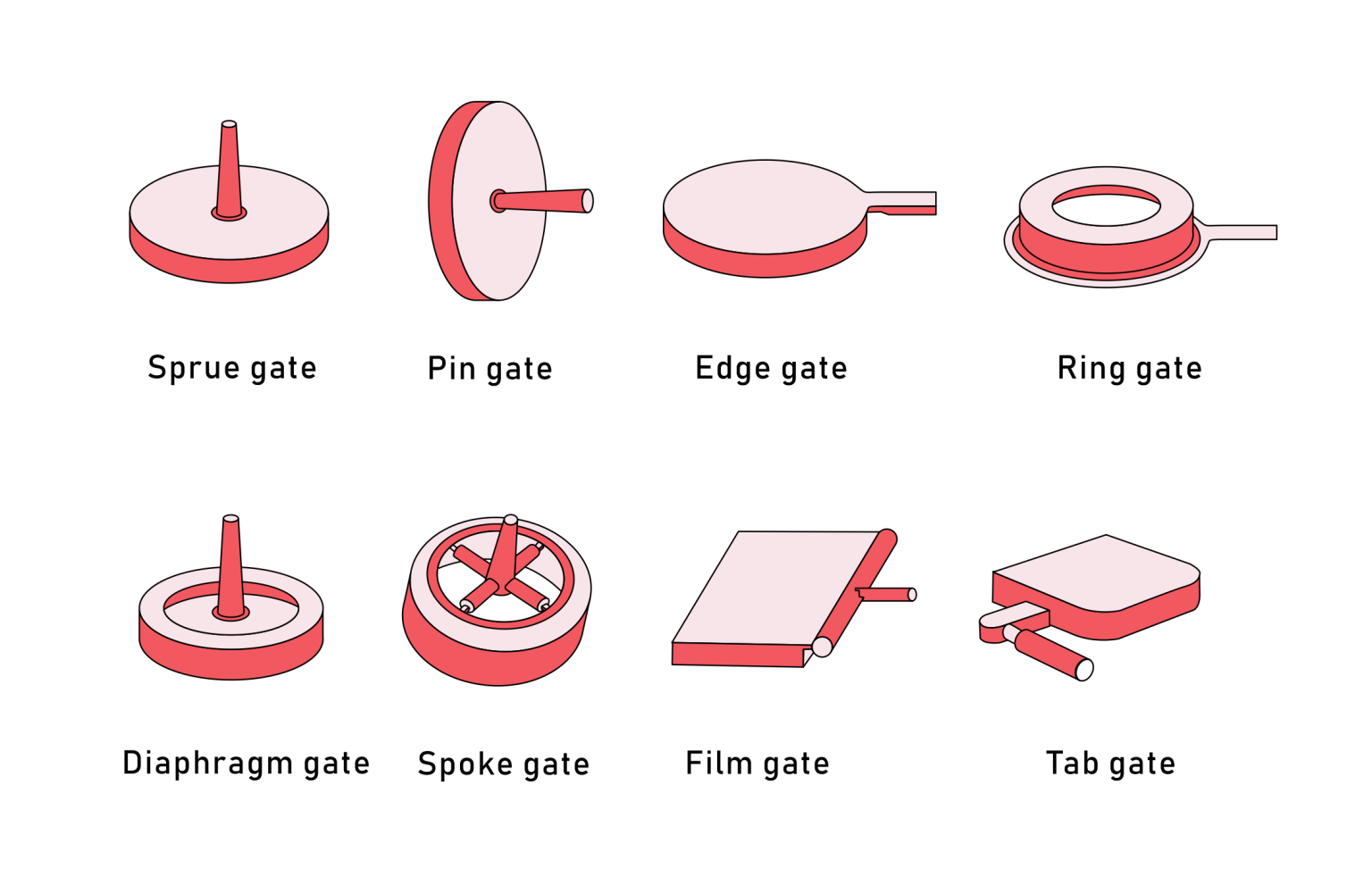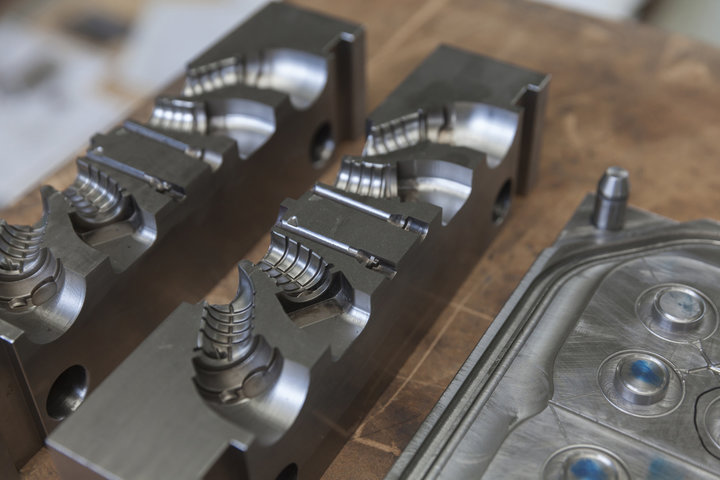Have you ever wondered how plastic products are made with such precision and consistency? The answer lies in the injection molding process, where molten plastic is injected into a mold cavity to create the desired shape. However, the success of this process heavily relies on the proper design and placement of gates.
Gates are the small openings through which the molten plastic enters the mold cavity, and their design can make or break the quality of the final product.In this post, you'll learn about the different types of gates used in injection molding and how each impacts the manufacturing process.
What Is An Injection Molding Gate?
An injection molding gate is a small opening that allows molten plastic to enter the mold cavity. It acts as a passageway, connecting the runner system to the part being molded.
Gates play a crucial role in the injection molding process. They control the flow rate, pressure, and direction of the molten plastic as it fills the cavity. Proper gate design ensures that the cavity is filled evenly and efficiently, resulting in high-quality parts with minimal defects.
The type, size, and location of gates can significantly influence the quality of molded parts. They affect:
Flow patterns and filling behavior
Cooling rates and shrinkage
Weld line formation
Surface appearance and aesthetics
Part strength and mechanical properties
Choosing the right gate design is essential for optimizing the injection molding process. It requires careful consideration of factors such as part geometry, material properties, and production requirements.

A simplified diagram showing the function of an injection molding gate.
Why Is Gate Design Important in Injection Molding?
Gate design is a critical aspect of injection molding. It directly impacts the quality of the final product. A well-designed gate ensures that molten plastic flows smoothly and evenly into the mold cavity. This results in parts with consistent dimensions, appearance, and mechanical properties.
On the other hand, poor gate design can lead to various defects and issues:
Short shots: Incomplete filling of the mold cavity
Weld lines: Visible lines where flow fronts meet
Sink marks: Surface depressions caused by uneven cooling
Warpage: Distortion of the part due to non-uniform shrinkage
Burn marks: Discoloration from overheating of the plastic
These defects not only affect the aesthetics of the part but also its functionality and durability. They can lead to increased scrap rates, rework, and customer complaints.
In contrast, well-designed gates offer numerous benefits:
Improved part quality and consistency
Reduced cycle times and increased productivity
Minimized material waste and scrap
Enhanced mechanical strength and performance
Easier post-molding operations (e.g., gate removal)
By optimizing gate design, manufacturers can streamline their injection molding process. They can produce high-quality parts more efficiently and cost-effectively.
Key Considerations for Gate Design
When designing gates for injection molding, there are several important factors to keep in mind. These considerations can make or break the success of your molded parts. Let's take a closer look at each one.
Gate Placement
Where you place the gate on your part is crucial. It determines how the molten plastic flows into the mold cavity. Ideally, you want to locate the gate:
At the thickest section of the part
Away from visible surfaces and key features
In a way that minimizes flow distance and resistance
Proper gate placement helps ensure even filling, reduces weld lines, and minimizes visible gate marks.
Gate Size
The size of the gate also plays a significant role. It affects the injection speed, pressure, and overall flow behavior. A gate that's too small can cause:
Incomplete filling (short shots)
High shear stress and material degradation
Longer cycle times and reduced efficiency
On the other hand, an oversized gate may lead to excessive material use and longer gate freeze times. Finding the optimal gate size is key to achieving a balance between part quality and production efficiency.
Part Shape and Finish
The geometry and desired surface finish of your part influence gate selection. Complex shapes, thin walls, and aesthetic requirements may dictate specific gate types. For example:
Edge gates for flat, wide parts
Pin gates for small, cylindrical components
Hot tip gates for parts with high surface quality demands
Matching the gate design to the part characteristics ensures better moldability and reduces the risk of defects.
Number of Gates Required
Depending on the size and complexity of your part, you may need multiple gates. This is especially true for large, flat components or parts with intricate features. Using multiple gates can:
Improve filling and packing of the mold cavity
Reduce weld lines and other flow-related defects
Shorten cycle times by allowing faster cooling
However, adding more gates also increases tooling costs and complexity. It's important to find the right balance based on your specific application and requirements.
| Consideration | Impact |
| Gate Placement | Flow behavior, weld lines, gate marks |
| Gate Size | Filling, shear stress, cycle time |
| Part Shape and Finish | Moldability, defects, surface quality |
| Number of Gates | Filling, packing, cycle time, tooling cost |
Summary of key gate design considerations and their impact on injection molding.
Types Of Injection Molding Gates

Injection molding gates come in various shapes and sizes, each with its own unique characteristics and applications. Let's explore some of the most common types of gates used in the industry.
1. Direct or Sprue Gates
Direct or sprue gates are the simplest and most basic type of injection molding gate. They consist of a straight, tapered channel that connects the nozzle directly to the mold cavity.
Characteristics:
Simple design and easy to manufacture
Large gate size allows for high flow rates
Suitable for thick-walled parts and large volumes
Advantages:
Low tooling costs and short lead times
Efficient for filling large, simple parts quickly
Minimal shear stress and material degradation
Disadvantages:
Leaves a large, visible gate mark on the part
May require manual gate removal and finishing
Not ideal for parts with thin walls or intricate features
Applications:
Large, thick-walled components
Non-critical parts where aesthetics are not a priority
Prototyping and low-volume production runs
2. Edge Gates
Edge gates are located at the edge of the part, usually along the parting line. They offer a simple and effective solution for many injection molding applications.
Characteristics:
Rectangular cross-section that tapers from the runner to the part
Can be easily trimmed or removed post-molding
Suitable for flat, thin-walled parts
Advantages:
Uniform filling and packing of the mold cavity
Minimal flow resistance and shear stress
Reduced risk of weld lines and other flow-related defects
Disadvantages:
Leaves a visible gate mark on the edge of the part
May require manual gate removal and finishing
Limited to parts with simple geometries and uniform wall thickness
Applications:
Flat, thin-walled components (e.g., plates, covers, panels)
Parts with non-critical appearance requirements
High-volume production runs
3. Submarine Gates
Also known as tunnel gates or sub gates, submarine gates are located below the parting line. They offer a hidden gate solution for parts with high aesthetic requirements.
Characteristics:
Angled or curved channel that enters the part below the surface
Gate is automatically trimmed during ejection
Suitable for small, cylindrical parts or those with undercuts
Advantages:
Leaves no visible gate mark on the part surface
Automatic gate removal reduces post-molding operations
Improved part appearance and quality
Disadvantages:
More complex and expensive tooling compared to other gate types
Limited gate size and flow rate
May cause uneven filling or packing in some cases
Applications:
Small, cylindrical components (e.g., pins, bushings, plugs)
Parts with high aesthetic requirements
Medical or consumer products where gate marks are unacceptable
4. Cashew Gates
Cashew gates, named after their resemblance to a cashew nut, are a variation of the submarine gate. They are used for parts with specific flow or gating requirements.
Characteristics:
Curved or S-shaped channel that enters the part at an angle
Gate is automatically trimmed during ejection
Suitable for parts with non-linear flow paths
Advantages:
Allows gating in hard-to-reach areas or at an angle
Automatic gate removal reduces post-molding operations
Improved part appearance and quality
Disadvantages:
Complex and expensive tooling compared to other gate types
Limited gate size and flow rate
May cause uneven filling or packing in some cases
Applications:
Parts with complex geometries or non-linear flow paths
Components with specific gating requirements or limitations
High-aesthetic parts where gate marks must be hidden
5. Diaphragm Gates
Diaphragm gates, also known as circular gates, are used for parts with cylindrical or conical shapes. They provide a uniform, radial flow of material into the mold cavity.
Characteristics:
Circular gate that surrounds the part or is located at the center
Provides a balanced, radial flow of material
Suitable for cylindrical or conical parts
Advantages:
Uniform filling and packing of the mold cavity
Reduced risk of weld lines and other flow-related defects
Improved part strength and consistency
Disadvantages:
May leave a visible gate mark on the part surface
Requires manual gate removal and finishing
Limited to parts with specific geometries
Applications:
Cylindrical or conical components (e.g., cups, containers, funnels)
Parts with a balanced, radial flow requirement
Products where gate placement at the center or periphery is desired
6. Hot Runner Valve Gates
Hot runner valve gates are used in conjunction with hot runner systems. They provide precise control over the flow of material and offer clean, gate-free part surfaces.
Characteristics:
Valve pin that controls the flow of material into the mold cavity
Provides a clean, gate-free part surface
Suitable for high-volume production and multi-cavity molds
Advantages:
Precise control over material flow and injection
Eliminates the need for gate removal and finishing
Reduced cycle times and improved production efficiency
Disadvantages:
Higher initial investment and maintenance costs
Complex setup and control systems required
May not be suitable for all materials or part geometries
Applications:
High-volume production runs with strict quality requirements
Multi-cavity molds for small, precise parts
Medical, automotive, or consumer products with no visible gate marks
7. Hot Runner Thermal Gates
Hot runner thermal gates are another type of gate used with hot runner systems. They offer improved flow and reduced cycle times compared to traditional cold runner systems.
Characteristics:
Heated nozzle that maintains material temperature and flow
Provides a clean, gate-free part surface
Suitable for high-volume production and multi-cavity molds
Advantages:
Improved material flow and reduced pressure drop
Eliminates the need for gate removal and finishing
Reduced cycle times and improved production efficiency
Disadvantages:
Higher initial investment and maintenance costs
Complex setup and control systems required
May not be suitable for all materials or part geometries
Applications:
High-volume production runs with strict quality requirements
Multi-cavity molds for small, precise parts
Medical, automotive, or consumer products with no visible gate marks
8. Fan Gates
Fan gates are a type of edge gate with a wide, fan-shaped opening. They are used for parts that require rapid filling and uniform distribution of material.
Characteristics:
Wide, fan-shaped gate that tapers from the runner to the part
Provides rapid filling and uniform distribution of material
Suitable for flat, thin-walled parts with large surface areas
Advantages:
Uniform filling and packing of the mold cavity
Reduced risk of weld lines and other flow-related defects
Improved part strength and consistency
Disadvantages:
Leaves a visible gate mark on the edge of the part
May require manual gate removal and finishing
Limited to parts with simple geometries and uniform wall thickness
Applications:
Flat, thin-walled components with large surface areas (e.g., panels, lids, trays)
Parts with non-critical appearance requirements
High-volume production runs
9. Pin Gates
Pin gates are small, cylindrical gates that are used for parts with thick walls or large cross-sections. They offer a concentrated flow of material into the mold cavity.
Characteristics:
Small, cylindrical gate that extends from the runner to the part
Provides a concentrated flow of material into thick or large parts
Suitable for parts with non-critical appearance requirements
Advantages:
Efficient filling and packing of thick or large parts
Reduced risk of short shots or incomplete filling
Minimal shear stress and material degradation
Disadvantages:
Leaves a visible gate mark on the surface of the part
May require manual gate removal and finishing
Limited to parts with thick walls or large cross-sections
Applications:
Thick-walled or large components (e.g., structural parts, housings, brackets)
Parts with non-critical appearance requirements
Low to medium-volume production runs
Factors Affecting Gate Selection
Choosing the right gate for your injection molding project is not a one-size-fits-all decision. Several factors come into play when selecting the optimal gate type and location. Let's explore these considerations in more detail.
Material Properties and Flow Characteristics
The type of plastic material you're using has a significant impact on gate selection. Different materials have varying flow properties, such as viscosity, shear sensitivity, and thermal stability. These characteristics influence how the molten plastic behaves as it enters and fills the mold cavity.
For example, high-flow materials like polyethylene (PE) and polypropylene (PP) may require larger gates to accommodate their fast flow rates. On the other hand, engineering plastics like polycarbonate (PC) and acrylonitrile butadiene styrene (ABS) may benefit from smaller, more precise gates to control their flow and minimize shear stress.
| Material | Flow Characteristics | Suitable Gate Types |
| PE, PP | High flow, low viscosity | Large gates (e.g., sprue, edge) |
| PC, ABS | Moderate flow, shear sensitive | Small gates (e.g., pin, valve) |
| Nylon, POM | Low flow, high viscosity | Medium gates (e.g., fan, submarine) |
Table 1: Material flow characteristics and suitable gate types.
Part Geometry and Wall Thickness
The shape and dimensions of your part also play a role in gate selection. Parts with complex geometries, thin walls, or non-uniform thicknesses may require specific gate types to ensure proper filling and minimize defects.
For instance, thin-walled parts may benefit from edge gates or fan gates, which provide a wide, shallow flow path to fill the cavity quickly and evenly. Thick-walled parts, on the other hand, may require pin gates or sprue gates to deliver a concentrated flow of material into the deep sections of the mold.

Figure 1: The relationship between part geometry and gate selection.
Mold Design and Construction
The design and construction of your injection mold can limit or enable certain gate types. The parting line location, ejector pin placement, and cooling channel layout all influence where and how gates can be incorporated into the mold.
Some gate types, like submarine gates or cashew gates, require specific mold features or additional machining to accommodate their unique shapes and entry points. Others, like hot runner gates, may necessitate more complex and expensive mold builds to integrate the heated manifold and nozzle components.
It's crucial to consider the mold design early in the process and collaborate with experienced toolmakers to ensure that the selected gate type is feasible and optimal for your specific application.
Production Volume and Efficiency Requirements
Your production volume and efficiency goals also influence gate selection. Different gate types offer varying levels of productivity, cycle times, and post-molding requirements.
For high-volume production runs, you may opt for gate types that minimize cycle times and enable faster part ejection, such as valve gates or thermal gates. These gate types also reduce the need for manual gate removal and finishing, further streamlining the production process.
However, these advanced gate systems come with higher initial costs and complexity compared to simpler gate types like edge gates or sprue gates. For low to medium-volume runs, these basic gate types may be more cost-effective while still meeting your quality and efficiency requirements.
| Production Volume | Efficiency Goals | Suitable Gate Types |
| High | Minimal cycle times, automated trimming | Valve gates, thermal gates |
| Medium | Balanced productivity and cost | Fan gates, submarine gates |
| Low | Cost-effective, manual trimming | Edge gates, sprue gates |
Table 2: Production volume, efficiency goals, and suitable gate types.
By carefully evaluating these factors and consulting with injection molding experts, you can select the optimal gate type for your specific application. The right gate selection can greatly enhance the quality, efficiency, and profitability of your injection molding project.
Conclusion
Selecting the proper gate type is crucial in injection molding. It impacts the quality and efficiency of the final product. Carefully consider the type and placement of gates in your designs. This decision can prevent defects and improve manufacturing outcomes. Consult with experienced professionals for guidance. They can help optimize your gate design and ensure the best results.
Team Mfg is your trusted partner for precision injection molding solutions. Contact us today, and let our experts optimize your project for success.












